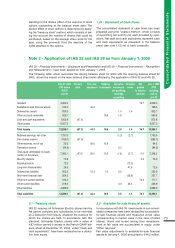APC 2005 Annual Report Download - page 80
Download and view the complete annual report
Please find page 80 of the 2005 APC annual report below. You can navigate through the pages in the report by either clicking on the pages listed below, or by using the keyword search tool below to find specific information within the annual report.
78
In addition, certain long-term receivables and loans to
subsidiaries are considered to be part of the Group’s
net investment, as defined by IAS 21 –
Net Investment
in a Foreign Operation
. In accordance with the rules
governing net investment hedging, the impact of
exchange rate fluctuations is recorded in equity and
recognized in the statement of income when the
investment is sold.
Interest rate swaps
Interest rate swaps, which synthetically adjust interest
rates on certain indebtedness, involve the exchange
of fixed and floating-rate interest payments. The differ-
ential to be paid (or received) is accrued (or deferred)
as an adjustment to interest income or expense over
the life of the agreement. The Group does not apply
hedge accounting as described in IAS 39 for interest
rate swaps. The impact is immediately recognized in
the income statement.
Commodity contracts
The Group also enters into commodity purchase con-
tracts including forwards, swaps and options to hedge
price risks on all or part of its forecast future purchas-
es. Under IAS 39, these qualify as cash flow hedges.
The hedging instruments are recognized in the bal-
ance sheet and are measured at fair value at the peri-
od-end. The portion of the gain or loss on the hedging
instrument that is determined to be an effective hedge
is accumulated in equity, under "Other reserves", and
reclassified into the income statement under "Cost of
sales" when the hedged transaction affects profit or
loss, leading to an adjustment of gross profit.The inef-
fective portion of the gain or loss on the hedging
instrument is recognized in "Other financial income
and expense".
Cash flows from derivative financial instruments are
recognized in the statement of cash flows in a manner
consistent with the underlying transactions.
Asset-backed securities issued by the Special
Purpose Entity holding perpetual bonds
In accordance with SIC 12 –
Special Purpose Entities
– and IAS 39, the special purpose entity that holds the
perpetual bonds is consolidated.
The swaps taken out by the special purpose entity in
connection with the perpetual bonds have been meas-
ured at fair value.
Interest rate swaps on the perpetual bonds taken out
directly by the Group are classified as derivative
instruments that do not qualify for hedge accounting.
They are therefore measured at fair value and gains
and losses arising from remeasurement at fair value
are recorded in "Other financial income and expense".
Put options granted to minority shareholders
Under IAS 32 –
Financial Instruments: Disclosure and
Presentation,
commitments to buy out minority share-
holders (e.g. put options) must be recognized in debt,
in an amount corresponding to the purchase price of
the minority interest. In the absence of established
accounting practice and pending publication of an
interpretation by the IFRIC specifying the accounting
treatment of the related adjustment, the difference
between the purchase price of the minority interests
and the share in the acquired net assets has been
posted to goodwill without remeasuring the acquired
assets and liabilities. Subsequent changes in the fair
value of the debt will be recognized by adjusting
goodwill.
1.22 - Revenue recognition
The Group’s revenues primarily include merchandise
sales and revenues from service and project con-
tracts.
Merchandise sales
Revenue from sales is recognized when the product is
shipped and title transferred (standard shipping terms
are FOB).
The Group offers rebates, calculated as a percentage
of sales, to some of its distributors when the distribu-
tor reaches a specified sales and volume objective. An
accrual is recorded as a deduction from revenue when
the products are sold to the distributor.
Additionally, in limited circumstances, the Group nego-
tiates global or national sales contracts directly with
international customers, at prices which might be less
than distributor prices. In these situations, the Group
compensates vendors for the difference between the
distributor’s price and the negotiated price. Certain
subsidiaries also offer cash discounts to distributors.
These discounts are deducted from sales.
Total sales are presented net of these discounts and
rebates.
Service contracts
Revenue from service contracts is recorded over the
contractual period of service. It is recognized when the
result of the transaction can be reliably determined, by
the percentage of completion method.
Long-term contracts
Income from long-term contracts is recognized using
the percentage-of-completion method, based either
on the percentage of costs incurred in relation to total
estimated costs of the entire contract, or on the con-
tract’s technical milestones, notably proof of installation
or delivery of equipment. When a contract includes
performance clauses in the Group’s favor, the related
revenue is recognized at each project milestone and a
provision is set aside if targets are not met.
Losses at completion for a given contract are provid-
ed for in full as soon as they become probable. The
cost of work-in-process includes direct and indirect
costs relating to the contracts.
1.23 - Earnings per share
Earnings per share is calculated in accordance with
IAS 33 –
Earnings per share.
Diluted earnings per share is calculated by adjusting
profit and the weighted average number of shares out-
























